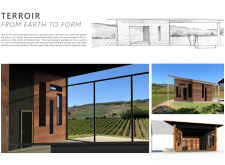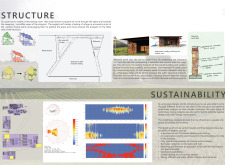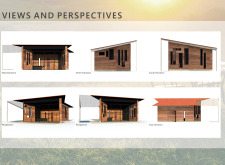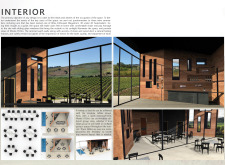5 key facts about this project
The architectural design project, "Terroir: From Earth to Form," is a wine tasting room located at Monte D'Oro. This structure embodies the relationship between wine production and the concept of terroir, reflecting the local environment's influence on the flavors of wine. The design focuses on creating an engaging experience for visitors, allowing them to connect with the vineyard surroundings while enjoying the wine.
The primary function of this architecture is to provide a dedicated space for wine tasting, equipped to accommodate different group sizes and events. It serves as an educational venue where visitors can learn about the winemaking process and the significance of the vineyard ecosystem in wine quality. The design promotes interaction between guests and their environment, making use of panoramic windows that frame views of the grapevines.
The project utilizes specific materials and design elements that distinguish it from typical wine tasting rooms. The use of rammed earth as a primary construction material results in walls that are not only structurally sound but also visually and texturally appealing. Local clay limestone is used to create varying hues, reinforcing the connection to the site's geology. This material provides excellent insulation, enhancing the building's energy efficiency.
The roof's angular form contributes to the architectural identity of the structure while facilitating natural ventilation, which is critical for comfort in a space designed for social engagement. Large, operable windows allow for cross-ventilation and maximize daylight, emphasizing the relationship between the indoor space and the outdoor vineyard landscape.
Sustainability features are central to the design approach. Incorporation of geothermal systems for heating and cooling reduces energy requirements. Rainwater harvesting systems are implemented for landscape irrigation and restroom usage, promoting water conservation. The use of energy-efficient fixtures throughout the space ensures minimal environmental impact during operation.
Distinctively, this project emphasizes a sense of place and cultural relevance, utilizing local materials and traditional building practices to create a meaningful space for wine tasting. It fosters an appreciation for the local terroir by allowing visitors to experience the vineyard's essence in a hands-on manner.
To gain deeper insights into this project, the exploration of architectural plans, architectural sections, and architectural designs will provide a comprehensive understanding of its innovative approaches and unique architectural ideas. An in-depth review of these elements will illustrate how this design represents a thoughtful synthesis of functionality and local context.






















































